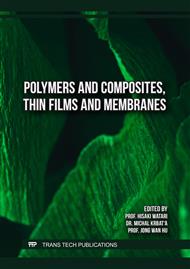[1]
J. Gupta, H. Shaik, and K. N. Kumar, "A review on the prominence of porosity in tungsten oxide thin films for electrochromic," International Journal of Ionics, vol. 27, no. 6, pp.1237-1266, 2021.
DOI: 10.1007/s11581-021-04035-8
Google Scholar
[2]
J.L. Solis, S. Saukko, L. Kish, C.G. Granqvist, and V. Lantto, "Semiconductor gas sensors based on nanostructured tungsten oxide," Thin Solid Films, vol. 391, no. 2, pp.255-260, 2001.
DOI: 10.1016/s0040-6090(01)00991-9
Google Scholar
[3]
Y. Shen, L. Pan, Z. Ren, Y. Yang, Y. Xiao, and Z. Li, "Nanostructured WO₃ films synthesized on mica substrate with novel photochromic properties," Journal of Alloys and Compounds, vol. 657, p.450–456, 2016.
DOI: 10.1016/j.jallcom.2015.10.103
Google Scholar
[4]
T. Sanjana, M. A. Sunil, H. Shaik, and K. N. Kumar, "Studies on DC sputtered cuprous oxide thin films for solar cell absorber layers," Materials Chemistry and Physics, vol. 281, p.125922, 2022.
DOI: 10.1016/j.matchemphys.2022.125922
Google Scholar
[5]
M. Horprathum et al., "NO₂-sensing properties of WO₃ nanorods prepared by glancing angle DC magnetron sputtering," Sensors and Actuators B: Chemical, vol. 176, no. 2, pp.685-691, 2013.
DOI: 10.1016/j.snb.2012.09.077
Google Scholar
[6]
A. Rydosz, K. Dyndał, K. Kollbek, W. Andrysiewicz, M. Sitarz, and K. Marszałek, "Structure and optical properties of the WO₃ thin films deposited by the GLAD magnetron sputtering technique," Vacuum, 2020.
DOI: 10.1016/j.vacuum.2020.109378
Google Scholar
[7]
L. M. Bertus and A. Duta, "Synthesis of WO₃ thin films by surfactant mediated spray pyrolysis," Ceramics International, vol. 38, no. 3, pp.2873-2882, 2012.
DOI: 10.1016/j.ceramint.2011.11.060
Google Scholar
[8]
E. Eren, C. Alver, and A. U. Öksüz, "Plasma modified WO₃ hybrids with altered donor groups for flexible electrochromic applications," University Journal of Science and Technology A: Applied Sciences and Engineering, vol. 19, pp.468-483, 2018.
DOI: 10.18038/aubtda.328064
Google Scholar
[9]
A. Al Mohtar, W. Kassem, M. Tabbal, and M. Roumie, "Formation of WO₃ by remote plasma assisted oxidation of tungsten thin films," Surface and Coatings Technology, vol. 321, pp.114-121, 2017.
DOI: 10.1016/j.surfcoat.2016.09.046
Google Scholar
[10]
MIT Plasma Science and Fusion Center, "What is plasma?" MIT Plasma Science and Fusion Center. [Online]. Available: https://www.psfc.mit.edu/vision/what_is_plasma. [Accessed: 20-Sep-2024].
DOI: 10.2172/1958406
Google Scholar
[11]
D. G. Petlin, S. I. Tverdokhlebov, and Y. G. Anissimov, "Plasma treatment as an efficient tool for controlled drug release from polymeric materials: A review," Journal of Controlled Release, vol. 266, p.57–74, 2017.
DOI: 10.1016/j.jconrel.2017.09.023
Google Scholar
[12]
A. Paliwal, M. Tomar, and V. Gupta, "Thickness dependent optical properties of WO₃ thin film using surface plasmon resonance," in Materials Research Society Symposium Proceedings, vol. 1494. Materials Research Society, 2013.
DOI: 10.1557/opl.2013.137
Google Scholar
[13]
C. Guillén and J. Herrero, "Amorphous WO₃₋ₓ thin films with color characteristics tuned by the oxygen vacancies created during reactive DC sputtering," Journal of Materials Science & Technology, vol. 78, p.223–228, 2021.
DOI: 10.1016/j.jmst.2020.11.036
Google Scholar
[14]
A.A. Yousif and A. I. Khudadad, "Effects of annealing process on the WO₃ thin films prepared by pulsed laser deposition," in IOP Conference Series: Materials Science and Engineering, vol. 745, no. 1, p.012064, 2020.
DOI: 10.1088/1757-899x/745/1/012064
Google Scholar
[15]
A. Achour, M. Islam, S. Solaymani, S. Vizireanu, K. Saeed, and G. Dinescu, "Influence of plasma functionalization treatment and gold nanoparticles on surface chemistry and wettability of reactive-sputtered TiO₂ thin films," Applied Surface Science, 2018.
DOI: 10.1016/j.apsusc.2018.07.145
Google Scholar
[16]
Y. Yamada, K. Tabata, and T. Yashima, "The character of WO₃ film prepared with RF sputtering," Solar Energy Materials & Solar Cells, vol. 91, no. 1, p.29–37, 2007.
DOI: 10.1016/j.solmat.2005.11.014
Google Scholar
[17]
K. J. Patel et al., "Thickness-dependent electrochromic properties of amorphous tungsten trioxide thin films," Journal of Nano- and Electronic Physics, vol. 9, no. 3, p.03040, 2017.
Google Scholar
[18]
C. Hom-on et al., "Spectroscopic analyses of sputtered aluminum oxide films with oxygen plasma treatments," Materials Science Forum, vol. 947, p.96–100, 2019.
DOI: 10.4028/www.scientific.net/msf.947.96
Google Scholar
[19]
Y. Guo and J. Yang, "Annealing effects on the structural and optical properties of WO₃ thin films," Journal of Materials Science & Technology, vol. 30, no. 7, p.702–707, 2014.
Google Scholar
[20]
B.H. Wu, J. Wu, F. Jiang, D.L. Ma, C.Z. Chen, H. Sun, and N. Huang, "Plasma characteristics and properties of Cu films prepared by high power pulsed magnetron sputtering," Vacuum, vol. 135, p.93–100, 2017.
DOI: 10.1016/j.vacuum.2016.10.032
Google Scholar


